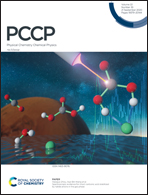Removal of H2S to produce hydrogen in the presence of CO on a transition metal-doped ZSM-12 catalyst: a DFT mechanistic study†
Abstract
Hydrogen sulfide (H2S) leads to corrosion in transport lines and poisoning of many catalysts. Meanwhile, H2S is an inexhaustible potential source of hydrogen, which is a very valuable chemical reagent and an environmentally friendly energy product. Therefore, removal of H2S and producing hydrogen gas using potential catalysts has been intensively studied, according to the equation: H2S(g) + CO(g) → COS(g) + H2(g). In this study, hydrogen sulfide (H2S) decomposition in the presence of CO over transition metal-doped ZSM-12 clusters (TM-ZSM-12) has been investigated based on DFT calculations at the B3LYP-D3/6-31G(d,p) level. The calculation results reveal that the proposed reaction mechanism is controlled by 4 key steps, (i) hydrogen dissociation (Ea1 = +0.04 eV for the 1st hydrogen and Ea2 = +0.22 eV for the 2nd hydrogen), (ii) COS desorption (the rate-determining step of this H2S removal process, Edes = +1.18 eV), (iii) hydrogen diffusion to the transition metal with an energy barrier (Ea3) of +0.62 eV, and (iv) the H2 formation step (Ea4 = +0.94 eV). Our results indicate that in the presence of CO, the Cu–ZSM-12 cluster has a potential application as a highly active catalyst for H2S removal together with hydrogen production.



 Please wait while we load your content...
Please wait while we load your content...